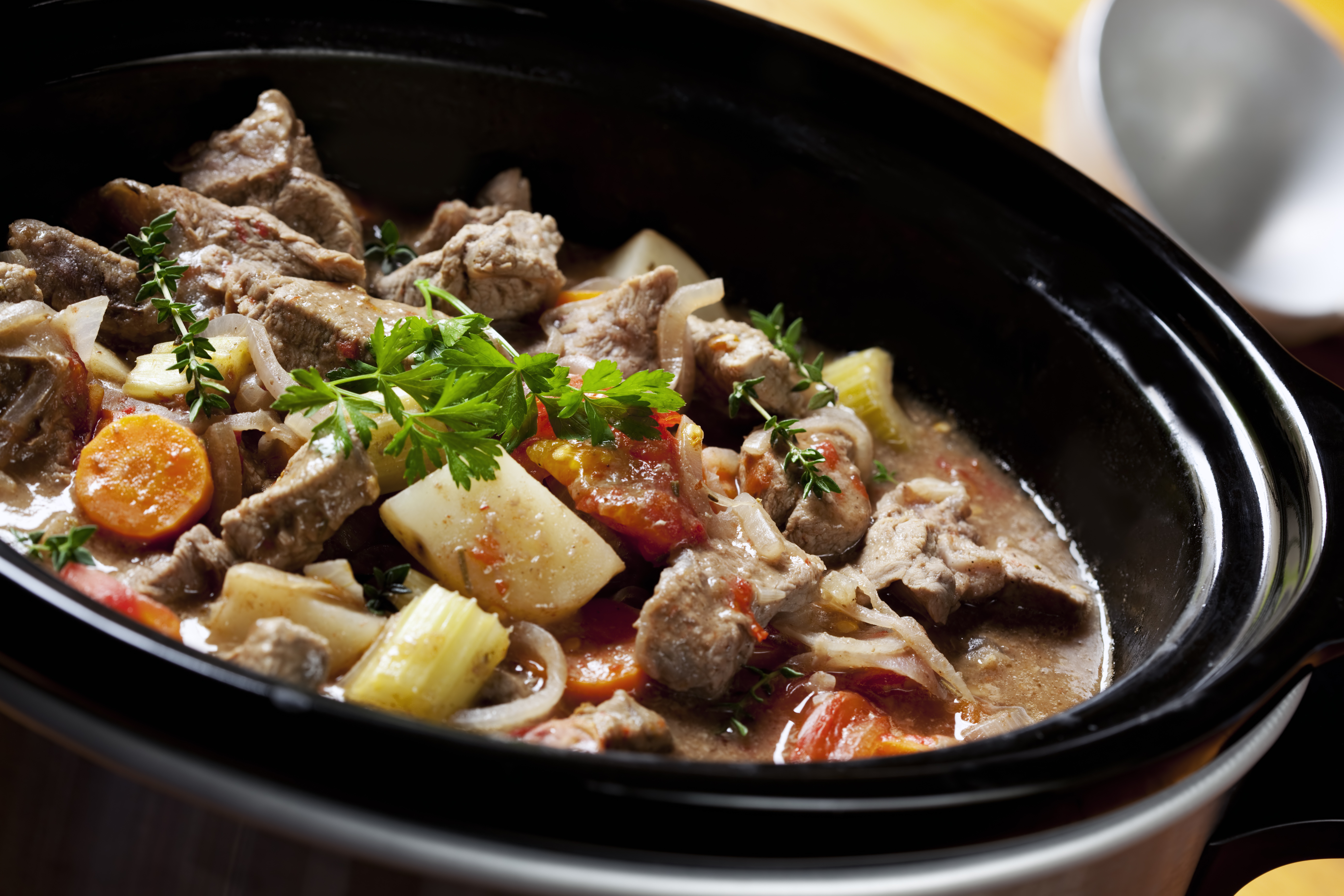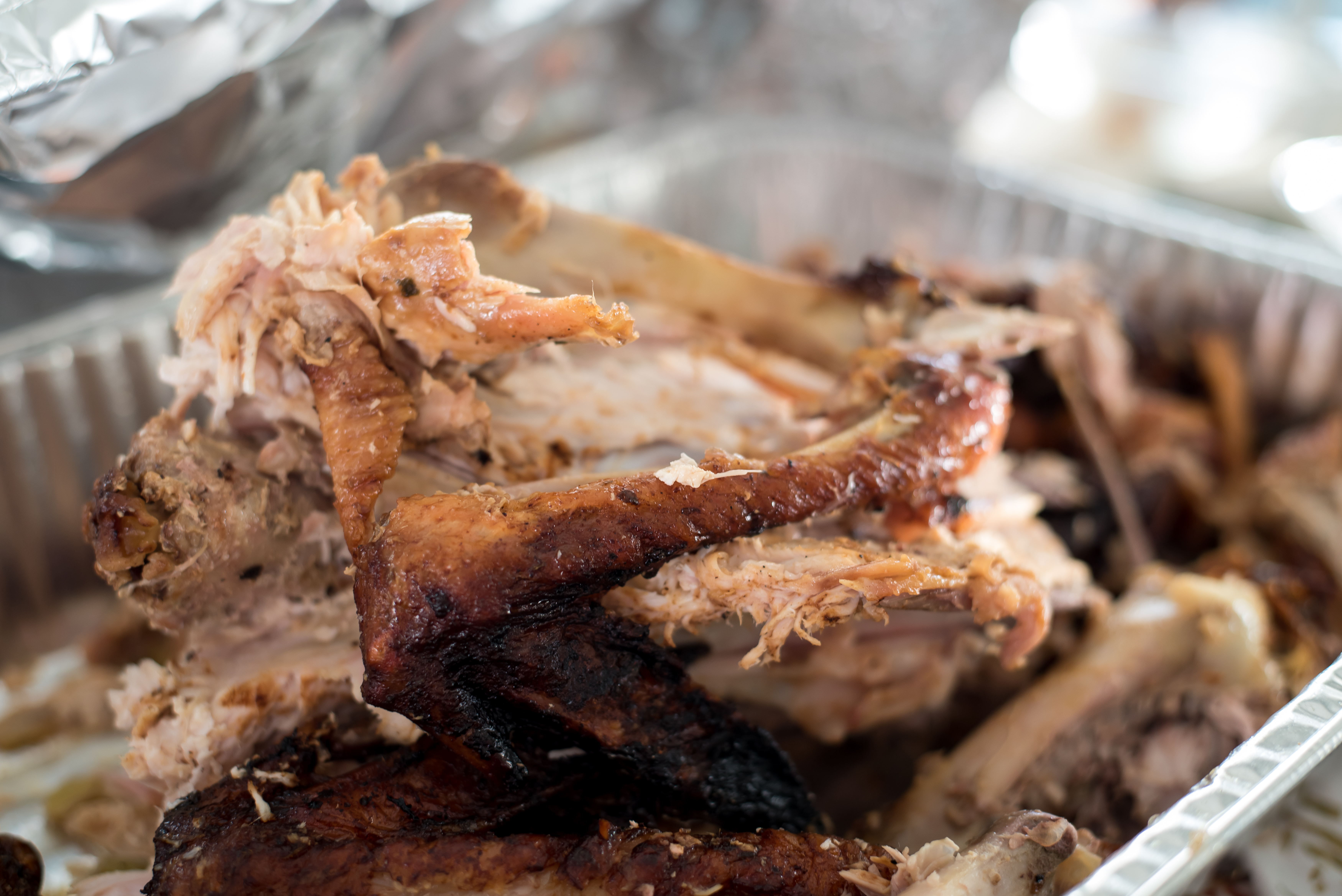
Roasting Those "Other" Holiday Meats

No doubt about it, holiday time is turkey time. Of the 218 million turkeys produced in 2023, 30 percent are served during the holidays. Yet numerous other meats are also traditional at holiday gatherings. Some families choose a rib roast; others, a ham; and some will have the butcher arrange a crown roast of lamb.
Whatever the choice, have a food thermometer on hand to determine when the meat has reached a safe temperature. For special holiday meals, the cook wants everything perfect — and perfectly safe.
The Safety of Special Holiday Meats
When choosing your holiday meat, be assured that all beef, lamb, pork, veal and poultry sold at your supermarket has been inspected for wholesomeness by the USDA or State inspection systems. Once your purchase is at home, refrigerate it immediately. Cook or freeze fresh poultry within 1 or 2 days; fresh meats, 3 to 5 days.
There are two types of hams: fully cooked and those that need cooking. Fully cooked hams may be eaten cold or reheated to 140 degrees F. When storing these hams, observe “use-by” dates on hams sealed at the plant; use store-wrapped cooked ham portions within 3 to 5 days. "Cook-before-eating" hams must be cooked to 145 degrees F and allowed to rest for at least 3 minutes to destroy harmful bacteria that may be present. Use within 7 days.
Since wild game killed by hunters has not been federally or state inspected, care must be taken to handle it safely. Parasites such as Trichinella and Toxoplasma may be present. Improper handling can cause bacterial contamination as well as off-flavors.
Dress game in the field right after shooting. Dressed meat must be chilled as soon as possible. Keep the game cold — below 40 degrees F, until it can be cooked or frozen. For more information about wild game, call State or county extension offices.
About Roasting
Because holidays are special times, people tend to spend more money for a specialty meat. These fancy meats and poultry may cost more because they are exceptionally tender or special.
Roasting is the recommended method for cooking tender meats. To roast, meat is placed on a rack in a shallow, uncovered pan and is cooked by the indirect dry heat of an oven. To keep the meat tender and minimize shrinkage due to the evaporation of moisture, a moderately low oven temperature of 325 degrees F should be used.
The USDA does not recommend cooking meat and poultry at oven temperatures lower than 325 degrees F because these foods could remain in the "Danger Zone" (temperatures of 40 to 140 degrees F) too long. Bacteria which may be present on these foods multiply rapidly at these temperatures.
Boned and rolled meats require more cooking time per pound than bone-in cuts because it takes longer for the heat to penetrate through the solid meat.
Background Information About Holiday Meats
BEEF and VEAL: Beef and veal are leaner these days so overcooking them will dry the meat. Cook all raw beef and veal steaks, roasts, and chops to a minimum internal temperature of 145 degrees F as measured with a food thermometer before removing meat from the heat source. For safety and quality, allow meat to rest for at least three minutes before carving or consuming. For reasons of personal preference, consumers may choose to cook meat to higher temperatures.
LAMB: Technically, “Spring lamb” is meat from lambs slaughtered from March to the first week in October. The term comes from a time when lambs born in harsh winter weather would have little chance to survive until the next year. Today, with more protected animal husbandry conditions, enjoying “lamb” is not confined to a particular season of the year.
Some people may view lamb as a fatty meat. However, leg and loin lamb meat has a similar fat content to lean beef and pork loin when trimmed of visible fat. The “fell” is a paper-like covering on lamb and is usually removed from steaks and chops at the retail market. Leave the fell on leg roasts to help retain shape.
Cook all raw lamb steaks, chops, and roasts to a minimum internal temperature of 145 degrees F as measured with a food thermometer before removing meat from the heat source. For safety and quality, allow meat to rest for at least three minutes before carving or consuming. For reasons of personal preference, consumers may choose to cook meat to higher temperatures.
PORK: Because hogs are about 50 percent leaner than they were 25 years ago, today's pork cooks faster and can dry out when overcooked. Years ago, when pork had more fat than it does today, the meat could be overcooked and still be fairly tender and flavorful.
Cook all raw pork steaks, chops, and roasts to a minimum internal temperature of 145 degrees F as measured with a food thermometer before removing meat from the heat source. For safety and quality, allow meat to rest for at least three minutes before carving or consuming. For reasons of personal preference, consumers may choose to cook meat to higher temperatures.
WILD GAME: To remove the “gamey” flavor, soak wild meat or poultry in a solution of either 1 tablespoon salt or 1 cup vinegar per quart of cold water. Use enough solution to cover the game completely and soak it overnight in the refrigerator. Discard the soaking solution before cooking.
Wild game is leaner than its domestically raised counterpart. Trim any visible fat — that's where a gamey flavor can reside. Then roast tender cuts of venison and game birds (if skinned) covered with oil-soaked cheesecloth or strips of bacon to prevent the meat from drying out. Set them on a rack in a shallow pan and roast in the oven at 325 degrees F.
For tenderness and doneness, whole game birds should be cooked to a safe minimum internal temperature of 165 degrees F as measured with a food thermometer in the innermost part of the thigh and wing and the thickest part of the breast.
DUCK and GOOSE: Most domestic ducks are the breed called White Pekin. The term "Long Island" duck is a trade name. Domestic ducklings have a great deal of fat. While it helps them float when swimming, fat is undesirable in a cooked duck. Therefore, it's recommended to prick or score the skin of a whole duck before cooking so much of the fat will render out.
Although domestic geese are larger than ducks, they are cooked in the same manner. Oven cooking bags are helpful for cooking these birds because they hold the fat for easy disposal and keep the oven spatter-free.
CAPONS and CORNISH HENS: These specialty birds are chickens. Cornish hens are small broiler-fryers weighing 1 to 2 pounds. Capons are male chickens which are surgically unsexed; weighing about 4 to 7 pounds, they have generous quantities of tender, light meat. Roast them as you would any chicken.
Holiday Meat Roasting Chart
For approximate cooking times to use in meal planning, see the following chart compiled from various resources. Cook all raw beef, pork, lamb and veal steaks, chops, and roasts to a minimum internal temperature of 145 degrees F as measured with a food thermometer before removing meat from the heat source. For safety and quality, allow meat to rest for at least three minutes before carving or consuming. For reasons of personal preference, consumers may choose to cook meat to higher temperatures.
| Holiday Meat Roasting Chart | |||
|---|---|---|---|
| Red Meat, Type | Oven degrees F | Timing | Minimum Internal Temperature & Rest Time |
| BEEF, FRESH | |||
| Beef, rib roast, bone-in; 4 to 8 pounds | 325 degrees F | 23 to 30 min/lb | 145 degrees F and allow to rest for at least 3 minutes |
| Beef, rib roast, boneless; 4 pounds | 325 degrees F | 39 to 43 min/lb | |
| Beef, eye round roast; 2 to 3 pounds | 325 degrees F | 20 to 22 min/lb | |
| Beef, tenderloin roast, whole; 4 to 6 lbs | 425 degrees F | 45 to 60 minutes total | |
| Beef, tenderloin roast, half; 2 to 3 lbs | 425 degrees F | 35 to 45 minutes total | |
| LAMB | |||
| Lamb, leg, bone-in; 5 to 9 pounds Lamb, leg, boneless; 4 to 7 pounds |
325 degrees F | 20-26 min/lb | 145 degrees F and allow to rest for at least 3 minutes |
| Lamb, crown roast; 3 to 4 pounds | 375 degrees F | 20-30 min/lb | |
| PORK, FRESH | |||
| Pork, loin roast, bone-in; 3 to 5 pounds | 325 degrees F | 20-25 min/lb | 145 degrees F and allow to rest for at least 3 minutes |
| Pork, loin roast boneless; 2 to 4 pounds | 325 degrees F | 23-33 min/lb | |
| Pork, crown roast; 6 to 10 lbs | 325 degrees F | 20-25 min/lb | |
| Pork, tenderloin; ½ to 1½ lbs | 425 degrees F | 20-30 minutes total | |
| PORK, CURED | |||
| Ham, cook-before-eating, bone-in; Whole, 14 to 16 pounds | 325 degrees F | 18-20 min/lb | 145 degrees F and allow to rest for at least 3 minutes |
| Ham, cook-before-eating, bone-in; Half, 7 to 8 pounds | 325 degrees F | 22-25 min/lb | |
| Ham, fully cooked, bone-in; Whole, 14 to 16 pound | 325 degrees F | 15-18 min/lb | 140 degrees F |
| Ham, fully cooked, bone-in; Half, 7 to 8 pounds | 325 degrees F | 18-25 min/lb | 140 degrees F |
| Ham, fully cooked, boneless; 3 to 4 lbs | 325 degrees F | 27-33 min/lb | 140 degrees F |
| Ham, country, dried | (see label directions) | ||
| VEAL | |||
| Veal, boneless roast, rump or shoulder; 2 to 3 pounds | 325 degrees F | 25-30 min/lb | 145 degrees F and allow to rest for at least 3 minutes |
| Veal, bone-in roast, loin; 3 to 4 pounds | 325 degrees F | 30-34 min/lb | |
| VENISON | |||
| Venison, round, rump, loin, or rib roast; 3 to 4 pounds | 325 degrees F | 20-25 min/lb | 160 degrees F |
Specialty Poultry Roasting Chart
For approximate cooking times to use in meal planning, see the following chart compiled from various resources. Use a food thermometer to determine that poultry reaches a safe minimum internal temperature. Check the internal temperature in the innermost part of the thigh and wing and the thickest part of the breast. For reasons of personal preference, consumers may choose to cook turkey to higher temperatures.
NOTE: Times are for unstuffed poultry. Add 15 to 30 minutes for stuffed birds. The internal temperature should reach 165 degrees F in the center of the stuffing.
| Specialty Poultry Roasting Chart | |||
|---|---|---|---|
| TYPE OF POULTRY | OVEN degrees F | TIMING | INTERNAL TEMP degrees F |
| CAPON, whole; 4 to 8 pounds | 375 degrees F | 20 to 30 min/lb | 165 degrees F |
| CORNISH HENS, whole; 18 to 24 oz. | 350 degrees F | 50 to 60 minutes total | 165 degrees F |
| DUCK, domestic, whole | 375 degrees F | 20 min/lb | 165 degrees F |
| DUCK, wild, whole | 350 degrees F | 18 to 20 min/lb | 165 degrees F |
| GOOSE, domestic or wild, whole | 325 degrees F | 20 to 25 min/lb | 165 degrees F |
| PHEASANT, young, whole, 2 pounds | 350 degrees F | 30 min/lb | 165 degrees F |
| QUAIL, whole | 425 degrees F | 20 minutes total | 165 degrees F |



